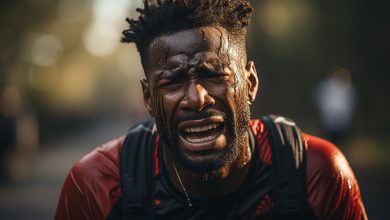When to See a Physical Therapist for Running-Related Injuries

Are you a runner experiencing nagging pain or discomfort? Don’t let those injuries slow you down! In this article, we’ll guide you on when it’s time to seek help from a physical therapist for your running-related injuries.
By understanding the signs and symptoms of these injuries, as well as the impact of your running form, you can make informed decisions about your treatment.
Let’s explore how physical therapy can play a crucial role in helping you get back on track to pain-free running.
Signs and Symptoms of Running-Related Injuries

If you’re experiencing persistent pain, swelling, or tenderness in your joints or muscles while running, it’s a good idea to see a physical therapist for an evaluation. Running-related injuries can be quite common and can significantly impact your ability to continue with your training. By recognizing the signs and symptoms of these injuries early on, you can seek appropriate treatment and prevent further damage.
Prevention strategies play a crucial role in avoiding running-related injuries. A physical therapist can assess your running mechanics, footwear, and training program to identify any potential risk factors that may contribute to injury. They can provide guidance on proper warm-up exercises, stretching routines, and strength training exercises tailored specifically for runners. Implementing these preventive measures can help reduce the likelihood of developing injuries during your runs.
In cases where injuries do occur despite preventive efforts, rehabilitation techniques become essential for recovery. Physical therapists utilize evidence-based treatments such as manual therapy techniques, therapeutic exercises, and modalities like ultrasound or electrical stimulation to address the underlying causes of the injury and promote healing. They also work closely with you to develop a personalized rehabilitation plan that includes progressive mobility exercises and functional training specific to running movements.
Understanding the Impact of Running Form on Injuries

Understanding how running form affects the likelihood of getting injured is essential for runners looking to prevent future issues. By analyzing and improving your running form, you can reduce the risk of running-related injuries and improve your overall performance.
Here are some key points to consider regarding the impact of running form on injuries:
– Proper alignment: Maintaining proper alignment throughout your body while running helps distribute forces evenly and reduces excessive stress on certain areas. This includes keeping your head aligned with your spine, shoulders relaxed, and hips level.
– Foot strike: The way your foot strikes the ground can have a significant impact on injury risk. Striking with the midfoot or forefoot instead of the heel can help absorb shock more efficiently and minimize stress on joints.
– Cadence: Increasing your cadence (number of steps per minute) can reduce overstriding, which often leads to increased impact forces and potential injuries. Aim for a cadence between 170-180 steps per minute.
– Arm swing: A controlled arm swing that moves in sync with your legs helps maintain balance and stability while running. Avoid crossing your arms over each other or swinging them excessively.
Common Running-Related Injuries and When to Seek Help

When experiencing persistent pain or limited mobility while running, it’s important to consult a trained professional for proper evaluation and guidance. Preventing running injuries is crucial in maintaining a healthy and active lifestyle. Understanding the common running-related injuries can help you identify when it’s time to seek help.
One of the most common running injuries is shin splints, which causes pain along the front of your lower leg. Another prevalent injury is runner’s knee, characterized by pain around or behind the kneecap. Plantar fasciitis, Achilles tendinitis, and IT band syndrome are also frequent among runners.
If you’re experiencing any of these issues or other persistent discomforts during your runs, seeking help from a physical therapist can be beneficial. They will conduct a thorough evaluation to determine the root cause of your pain and develop a personalized treatment plan. This may include rehabilitation exercises that focus on strengthening weak muscles, improving flexibility, and correcting imbalances.
The Role of Physical Therapy in Treating Running Injuries

Physical therapy plays a crucial role in treating and rehabilitating common running injuries. When you experience a running-related injury, seeking the help of a physical therapist can greatly benefit your recovery and overall rehabilitation process.
Here are some key benefits of physical therapy for running injuries:
– Pain management: A physical therapist will assess your injury and develop a personalized treatment plan to help alleviate pain. They may use techniques such as manual therapy, therapeutic exercises, or modalities like heat or ice packs.
– Correcting biomechanical issues: Your physical therapist will evaluate your movement patterns and identify any biomechanical abnormalities that may have contributed to your injury. Through targeted exercises and interventions, they can help correct these issues to prevent future injuries.
– Strengthening weak muscles: Weak muscles are often a contributing factor to running injuries. Your physical therapist will work with you to strengthen specific muscle groups, improving their function and reducing the risk of further injury.
– Improving flexibility and range of motion: Physical therapists use stretching techniques and mobility exercises to improve flexibility and restore normal range of motion in injured joints or muscles.
Overall, physical therapy is an essential component of the rehabilitation process for runners with injuries. It not only helps manage pain but also addresses underlying causes while promoting healing, strength, and optimal performance.
When to Transition From Self-Treatment to Professional Help

If you’ve been trying to manage your running injury on your own, it might be time to consider seeking professional help for a more effective and tailored treatment plan. While self-treatment can sometimes be beneficial in the early stages of an injury, there comes a point when transitioning to professional help becomes necessary.
One important factor to consider is the transition timeline. If you have been diligently following a self-treatment plan for several weeks or even months without significant improvement, it may be time to seek the expertise of a physical therapist. They can provide a fresh perspective and offer advanced techniques that can accelerate your recovery.
There are several benefits of self-treatment, such as convenience and cost-effectiveness. However, it’s essential to recognize that self-treatment has its limitations. Professional physical therapists undergo extensive training and have in-depth knowledge of biomechanics, anatomy, and evidence-based treatments specifically tailored for running-related injuries.
By seeking professional help at the right time, you can ensure that you receive appropriate care based on your individual needs. Physical therapists will assess your condition thoroughly and develop a comprehensive treatment plan that addresses the root cause of your injury rather than just managing symptoms. This personalized approach enhances recovery outcomes and reduces the risk of recurring injuries.
Conclusion
In conclusion, it is crucial to know when to seek help from a physical therapist for running-related injuries. By recognizing the signs and symptoms of these injuries, understanding the impact of running form, and being aware of common running-related injuries, you can make informed decisions about when to transition from self-treatment to professional help.
Physical therapy plays a vital role in treating these injuries by providing evidence-based interventions that address both the underlying causes and symptoms. Remember, ‘a stitch in time saves nine,’ so don’t hesitate to seek professional help if needed.






